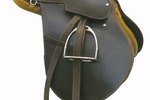Luitpold Pharmaceuticals founded its Animal Health Division in 1984 with the goal of developing and manufacturing a treatment for degenerative joint disease (DJD) in horses and, later, to finding treatments for osteoarthritis in dogs. Adequan is the result.
What Is Adequan?
Adequan is polysulfated glycosaminoglycan or PSGAG.
Uses
Adequan works by inhibiting enzymes that break down cartilage and slowing its degeneration. It also reduces joint inflammation and pain, and improves lubrication of joints.
Forms
Adequan comes in two forms for horses, Adequan i.a. (intra-articular) and Adequan i.m. (intra-muscular), and one for dogs, Adequan Canine.
Differences
Except for the dosing regimen, no significant differences exist between equine and canine Adequan, according to Dr. Gary Kaufman, a veterinarian in Scottsdale, Arizona. Injections of Adequan i.a. go directly into the joint, while Adequan i.m. and Adequan Canine are injected into the muscle.
Percentage of PSGAG
Adequan i.a. has a higher percentage of PSGAG by weight composition—at 25 percent—than Adequan Canine and Adequan i.m., which are both at 10 percent, according to the product inserts.
Manufacturer
Novartis has manufactured Adequan Canine since 2004, while Luitpold still makes the equine versions.
References
- Luitpold Pharmaceuticals Website
- Dr. Gary Kaufman, DVM; Scottsdale, Arizona
- Luitpold Animal Health Product Insert
Photo Credits
-
Jupiterimages/Brand X Pictures/Getty Images




